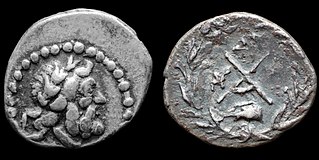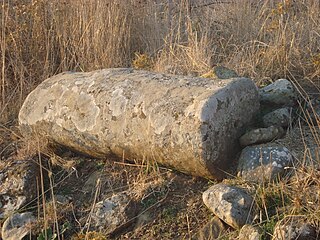Related Research Articles

The Pythian Games were one of the four Panhellenic Games of Ancient Greece. They were held in honour of Apollo at his sanctuary at Delphi every four years, two years after the Olympic Games, and between each Nemean and Isthmian Games. The Pythian Games were founded sometime in the 6th century BC. In legend they were started by Apollo after he killed Python and set up the oracle at Delphi. They continued until the 4th century AD.

Cynisca or Kyniska was a wealthy Spartan princess. She is famous for being the first woman to win at the Olympic Games, competing in the sport of chariot racing. Cynisca first entered the Olympics in 396 BC, where she won first prize competing with a team of horses she had trained herself. In 392 BC, Cynisca entered her horses in the Olympics for a second time and was awarded another victory in the same event.
Aegium or Aigion, or Aegeium or Aigeion (Αἴγειον), was a town and polis (city-state) of ancient Achaea, and one of the twelve Achaean cities. It was situated upon the coast west of the river Selinus, 30 stadia from Rhypae, and 40 stadia from Helice.
Chionis of Sparta or Chionis of Laconia was an ancient Greek athlete who won multiple events at the ancient Olympic Games representing the city of Sparta in Laconia. Eusebius of Caesarea lists Chionis as victor in both the stadion and diaulos races at the 29th, 30th and 31st Olympiads. Pausanias' Description of Greece credits Chionis with a fourth stadion victory in the 28th games of 668 BC, which Eusebius assigns to Charmis of Sparta. Pausanias says that Chionis was an oikist at Battus of Thera's foundation of Cyrene, Libya. Paul Christesen suggests that claim may, on the one hand, date from much later heroization of Chionis by Sparta's Agiads seeking an alliance with Cyrene, but, on the other hand, may have some basis in fact.
Astylos of Croton was an athlete from ancient Croton who starred in the Olympic Games of the 5th century BC. He was mentioned in records from General Pausanias that claim he excelled in three successive Olympic games from 488 to 480 BC, in the running events of stadion and diaulos. Diodorus Siculus calls him Astylos of Syracuse and uses his third victory to date the Persian invasion in 480 BC..". In Italy, Astylos was famous for equaling the achievements of previous champion athlete Chionis of Sparta. Astylos matched the achievements of Chionis by winning the stadion and diaulos events on three occasions, as well as winning the hoplitodromos event.

Dyme, or Dymae, was a town and polis (city-state) of ancient Achaea, and the most westerly of the 12 Achaean cities, from which circumstance it is said to have derived its name.The location of Dyme is near the modern Kato Achaia.
The Heraea was an ancient Greek festival in which young girls competed in a footrace. The race was held every four years at Olympia, and probably took place around the same time as the ancient Olympic Games.

The ancient Olympic Games were a series of athletic competitions among representatives of city-states and one of the Panhellenic Games of Ancient Greece. They were held in honor of Zeus, and the Greeks gave them a mythological origin. The first Olympic Games are traditionally dated to 776 BC. The games were held every four years, or Olympiad, which became a unit of time in historical chronologies. They continued to be celebrated when Greece came under Roman rule, 2nd century BC. Their last recorded celebration was in AD 393, under the emperor Theodosius I, but archeological evidence indicates that some games were still held after this date. The games likely came to an end under Theodosius II, possibly in connection with a fire that burned down the temple of the Olympian Zeus during his reign.
Sostratus is mentioned in Pausanias' Description of Greece as a Greek mythological hero, reputedly beloved of Heracles.
Sostratus was an Ancient Greek athlete from Pellene, Achaea. He won the footrace for boys at the Ancient Olympic Games. He was the first Achaean to win at the Olympics since Oebotas of Dyme. According to legend, Oebotas had cursed the Achaeans for not giving him a special prize after his Olympic victory, so that no Achaean should win at the Olympics. When the Achaeans had dedicated a statue to Oebotas in Olympia, the curse was broken and Sostratus could win.
Philinus of Cos, son of Hegepolis, was an ancient Greek athlete and five times Olympic winner.

Achaea or Achaia was the northernmost region of the Peloponnese, occupying the coastal strip north of Arcadia. Its approximate boundaries were to the south the mountain range of Erymanthus, to the south-east the range of Cyllene, to the east Sicyon, and to the west the Larissos river. Apart from the plain around Dyme, to the west, Achaea was generally a mountainous region.
Pellene was a city and polis (city-state) of ancient Achaea, the most easterly of the twelve Achaean cities. Its territory bordered upon that of Sicyon on the east and upon that of Aegeira on the west. Pellene was situated 60 stadia from the sea, upon a strongly fortified hill, the summit of which rose into an inaccessible peak, dividing the city into two parts. Its port was at Aristonautae.

The Achaean War of 146 BC was fought between the Roman Republic and the Greek Achaean League, an alliance of Achaean and other Peloponnesian states in ancient Greece. It was the final stage of Rome's conquest of mainland Greece, taking place just after the Fourth Macedonian War.
Eurybus of Athens was an ancient Greek athlete listed by Eusebius of Caesarea as a victor in the stadion race of the 27th Olympiad. His name is also referred as Eurybates or Eurybotos and possibly Eurybotas elsewhere in Pausanias, both of the latter two have been anglicised to "Eurybotus" by editors, although elsewhere the distinction is preserved. He was the second winner from Athens preceded only by Pantacles.
Icarius of Hyperesia was an ancient Greek athlete listed by Eusebius of Caesarea as a victor in the stadion race of the 23rd Olympiad. After Oebotas of Dyme he was the second runner from Achaea to win at the Olympic Games. Pausanias refers to him as Ikaros.

Olenus or Olenum was a polis (city-state) in ancient Achaea, Greece. It was an original member of the Achaean League, one of the 12 Achaean cities, situated on the coast, and on the left bank of the river Peirus, 40 stadia from Dyme, and 80 stadia from Patrae. On the revival of the Achaean League in 280 BCE, it appears that Olenus was still in existence, as Strabo says that it did not join the league; but the inhabitants subsequently abandoned the town, and retired to the neighbouring villages of Peirae (Πειραί), and Euryteiae (Εὐρυτειαί), and to Dyme. In the time of Polybius, however, Olenus was no longer inhabited; and in the time of Pausanias it was in ruins, and its territory belonged to Dyme.

Tritaea or Tritaia was a polis (city-state) of Achaea, and the most inland of the 12 Achaean cities, was distant 120 stadia from Pharae. According Pausanias, Tritaea's foundation was said to be due to either: Celbidas, who came from Cumae; or Melanippus, a son of Ares and Triteia, herself a daughter of Triton and priestess of Athena, and that Melanippus named the town after his mother.
Aristaenus of Megalopolis, was sometimes called "Aristaenetus" by Polybius and Plutarch. Aristaenus, however, appears to be the correct name.
References
- ↑ Eusebius. Chronicon (English translation from Latin, original Greek lost) at Attalus.org
- 1 2 Pausanias. Description of Greece, Book 7 Archived 2016-07-03 at the Wayback Machine .
- ↑ Pausanias Description of Greece 7.17.13, 7.17.14
